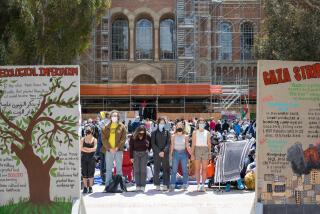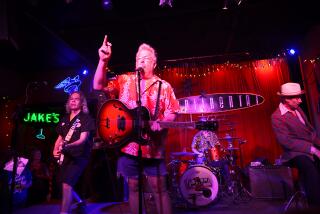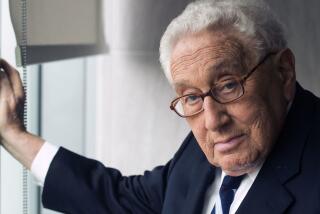COMMENTARY : Nixon Library a Triumph Even With Omissions
There is much to criticize, including some lies, some continuing cover-up and some glaring omissions, but overall the Nixon Library and Birthplace is a stunning triumph.
It is easily the best of all the presidential museums in terms of size, scope, coverage, use of audio and visual material, and just plain appeal to people. This is partly because it is the most expensive at $21 million, partly because it is the most imaginative in concept and design, but mainly it is because of the subject. Nixonâs longevity in national politics and his central role in many of the great events of the last century combine to provide an ideal theme around which to build a dramatic museum.
Nixon, naturally and inevitably, dominates everything. The purpose of the museum is more to glorify Nixon than to explain him, as is true of every presidential museum. There is not a hint of criticism about anything he ever did.
With the exception of the gift store that features Nixon as author, this is a library without books or manuscripts. Although some research materials are promised next year, the truth is the name of the establishment is deliberately misleading. It is not a library; it is the Richard Nixon museum.
As such, the biggest disappointment is the treatment of Nixon and Vietnam. The biggest surprise is the fairly extensive, albeit one-sided, treatment given to Watergate. The best section is Nixonâs early life and campaigns. The most appealing segments cover Pat Nixon and family life.
In the entry hall, the initial display covers Nixonâs ancestors, parents and life before he entered politics. Some highlights include evocative photos of Yorba Linda and Whittier in the early 20th Century and good coverage of his college days and early law practice.
To get to the museum proper, visitors go through a movie theater where there is a continuous showing of a 25-minute film on Nixonâs life. It is a piece of campaign puffery that will embarrass all but the most extreme Nixon supporters and infuriate his foes.
Emerging from the theater, a wall display carries 30 of the 66 Time magazines with Nixon on the cover, easily the record. Then the museum moves on to Nixonâs first campaign, in 1946 for Congress, against incumbent Jerry Voorhis. It is visually attractive and relatively fair; for example, the display does mention that Voorhis had been voted the âhardest-workingâ congressman in the House. It mentions, if only briefly, Nixonâs red-baiting of Voorhis. What it does not do is provide an understanding at all of why it was that, starting with this campaign, so many people hated Nixon so much.
Indeed, it is a major shortcoming of the entire museum that nowhere is there any attempt to grapple with the problem of why Nixon, more so than any other politician of this century, elicited so much hatred.
Considering the importance of the Alger Hiss spy case to Nixonâs career, and the political courage he showed in pursuing Hiss after older Republicans advised him to back off, the Hiss display is disappointingly brief.
It does contain a replica of the Woodstock typewriter that ultimately nailed Hiss, and it does have one of the State Department documents Hiss stole to give to the Soviets, but there is relatively little on Whitaker Chambers, who fingered Hiss. There is absolutely nothing on why an aristocrat like Hiss would find communism a compelling ideology, or on why Nixon, the kid from the wrong side of the tracks on the wrong coast of the country, would so resent this Ivy League intellectual.
The 1950 campaign against Rep. Helen Gahagan Douglas for the U.S. Senate has three items of special interest: the first is the infamous âpink sheetâ in which Nixon implied that Douglas was at best a communist sympathizer and at worst an active agent of the Communist Party. It was red-baiting at its lowest, according to Nixonâs critics.
The second is another handbill, put out by Douglas, in which she charged that it was Nixon who voted the Communist Party line. Her attempt to red-bait Nixon is something his critics have either ignored or long since forgotten. The third is a replica of the late 1940s station wagon in which Nixon toured the state and which was the real key to his landslide victory--he just worked so hard.
The highlight of Nixonâs 1952 vice presidential campaign is a long excerpt from his âCheckersâ speech played on a small television set, in which Nixon successfully defended himself against charges he accepted money from a slush fund. This was the first major political event on television in American history, and the speech introduces a theme that dominates the remainder of the museum--Nixon and TV. The âCheckersâ speech was only separated from the Senate campaign by two years--but what a difference. In 1950, he spoke to hundreds from the top of his station wagon; in 1952, to millions via TV.
Nixonâs eight years as vice president are covered in a series of wonderful photographs. His foreign trips get the biggest play, with the emphasis on his 1958 South American tour when he was stoned and spat upon, and his 1959 âkitchen debateâ with Soviet leader Nikita Khrushchev when Nixon told him he was guilty of enslaving millions.
The vice presidential section also contains a document that will surprise many visitors, a long letter written in 1957 from Martin Luther King Jr. praising Nixon for his forthright advocacy of civil rights.
The central feature of the coverage of the 1960 campaign is a period living room with two sofas for visitors to sink into as they watch the Kennedy-Nixon debates on a small black-and-white TV. The footage is well-chosen; the commentary emphasizes that it was in the first debate that Nixon learned that style was more important than substance. Most viewers thought Kennedy won, because he looked so much better than Nixon on television; most voters who listened on the radio felt Nixon won. The museum does not claim that the election was stolen by the Democrats; it does stress the close vote.
Nixon was, as former President Lyndon B. Johnson once observed, a chronic campaigner. The next campaign came in 1962, against Edmund G. (Pat) Brown for governor of California. The treatment is as bland as was the campaign. The only real excitement came the morning after Nixon lost the election when he held his âlast press conferenceâ and said reporters wouldnât have him to kick around anymore. Filmed footage of that press conference exists, but no part of it is shown in this museum. That is a mistake and a pity, as the news conference shows Nixon at his best and worst.
Nixonâs âwilderness years,â 1963-67, are skipped over quickly. There is no inkling of Nixonâs role as the leading hawk on Vietnam, constantly criticizing Johnson for not escalating the war. Nixon called for more men and more bombs daily and loudly--but not in this display.
The following room, called âWorld Leaders,â is absolutely stunning, extraordinary and all but overwhelming. By itself, it makes a visit to this museum worth a trip. The room consists of 10 life-size bronze statues of leaders Nixon dealt with in his long career, posed in relaxed postures, chatting with each other.
The display on Nixon as president concentrates on the opening with China, with precious little mention of the fact that for 20 years, Nixon was the American politician most responsible for the isolation of China. Nixonâs love affair with China and with Mao Tse-tung is evident everywhere, to the point where the surprisingly brief section on Nixonâs relations with Soviet leader Leonid Brezhnev is contained within a Chinese pagoda. There is almost nothing on arms control or other aspects of Nixonâs detente policy, a curious omission.
The treatment of the Vietnam War is extremely one-sided. There is no agonizing, there are no doubts--Nixon was right, the doves were criminally wrong. Almost all of Nixonâs Nov. 3, 1969, âsilent majorityâ speech is shown on a color television set. The commentary asserts that âthis speech remains the milestone against which all other presidential addresses are judged.â One wonders what happened to the Gettysburg Address.
Barely mentioned are the 1970 Cambodian incursions and the Kent State tragedy in which National Guardsmen killed four students during a demonstration. The 1971 invasion of Laos is not mentioned at all, the Christmas, 1972, bombing of Hanoi is downplayed and no attempt is made to explain why Nixon launched the bombing or what he got from it.
The next room belongs to Pat Nixon, and it shows this truly great woman as she really is, heartwarming and wholesome, kind and considerate, loyal and hard-working. There are dozens of photos showing her from childhood to old age. Many presidential libraries feature a re-creation of the Oval Office. The Nixon Library re-creates the Lincoln Sitting Room. There is Nixonâs stuffed chair, his ottoman, his pipe and his legal pad. A wall display contains many yellow sheets with Nixonâs speech and book drafts scribbled on them.
A single large room covers domestic affairs. The theme is âNixon the innovator,â which is a tough sell in some cases. The Environmental Protection Agency, for example, is offered as an illustration of Nixon as the far-seeing statesman without noting that he signed the bill creating the agency reluctantly and only after forcing the Democrats to soften the bill considerably. On energy conservation, the museum understates Nixonâs farsightedness. He was urging Congress to reduce oil consumption and to increase domestic oil production six months before the 1973 Arab oil embargo caused the energy crisis.
There is only one tiny display on Nixonâs vice presidents, Spiro T. Agnew and Gerald R. Ford. There is not one mention of Fordâs pardon of Nixon, an omission that is inexcusable. Also inexcusable is the absence of any reference to illegal surveillance or wiretapping activities against anti-Vietnam War activists.
Watergate is covered in a single long, dark uninviting room with more written commentary than any other section. The presentation makes the best possible case for Nixon, mainly in Nixonâs own words, and is entirely self-serving. There is one Watergate tape, complete with a headset, but it is far from complete and a commentator puts a spin on the tape that would almost convince a listener that Nixon never ordered a cover-up or a payment of hush money.
Two things stand out about the Watergate treatment. First, it is impossible to make a solid case for Nixon, because he was guilty. The museum does the best it can with a hopeless case. Second, there is no attempt to assess the meaning of Watergate, or to describe what, if anything, was learned from the greatest political crisis of this century.
But then it is not the purpose of museums to be retrospective, or to be critical, but rather it is to praise and honor. The Nixon Museum does this well. It allows the man it glorifies to speak in his own words, to make his own case. Nowhere is this better done than in the Presidential Forum room, the last in the tour. Visitors touch a computer display to ask Nixon a question--there are about 800 listed--and he comes on screen with the answer taped from past public appearances and a recently taped interview.
Nixon is the most fascinating of all our 20th-Century politicians. His museum is almost as fascinating as the man himself, and frequently as contradictory, and often as contentious and always as partisan. It is a personal triumph for Nixon--his supporters will love it, his critics will gnash their teeth--and who could doubt but that this is just the way that Richard Nixon wants it?
More to Read
The biggest entertainment stories
Get our big stories about Hollywood, film, television, music, arts, culture and more right in your inbox as soon as they publish.
You may occasionally receive promotional content from the Los Angeles Times.










